Telangana TSBIE TS Inter 1st Year Economics Study Material 2nd Lesson Theories of Consumer Behaviour Textbook Questions and Answers.
TS Inter 1st Year Economics Study Material 2nd Lesson Theories of Consumer Behaviour
Long Answer Questions
Question 1.
Describe the law of diminishing marginal utility, its limitations and importance. [Mar. ’16]
Answer:
Hermann Heinrich Gossen was the first economist to explain the law of diminishing marginal utility in 1854. It is also known as Gossen’s ‘first law’. In 1890, Marshall in his principles of economics developed and popularised this analysis. This law explains the functional relationship between the stock of commodity and the marginal utility of commodity.
According to Marshall, “The additional benefit which a person derives from a given increase of his stock of a thing diminishes with every increase in stock that he already has”.
“As a consumer increases the consumption of any one commodity, keeping constant the consumption of all other commodities, the marginal utility of the variable commodity must eventually decline”. Kenneth E.Boulding.
The law says that as we gone consuming a commodity, satisfaction that derives from its additional units goes on diminishing.
Assumptions :
1) Rationality :
Consumer is a rational man which means he always tries to get maximum satisfaction.
2) Cardinal Measurement of Utility :
Utility is a cardinal concept i.e., utility can be measured and compared numerically.
3) Utilities are Independent :
It implies that utility of any commodity depends on its own quantity.
4) Homogeneous :
Units of the commodity are similar in quantity, size, taste and colour etc.
5) No Time Lag :
There should not be any time lag between the consumption of one unit and other unit.
6) Constant Marginal Utility Unit :
It is assumed that the marginal utility of money remains constant.
7) Total & marginal utility :
Total utility: Total satisfaction obtained by the consumer from the consumption of a given quantity of commodity.
TUn = f(Qn)
Where, TUn = Total utility of n commodity,
f = functional relationship,
Qn = Quantity of n commodity.
Marginal utility :
Marginal utility is the addition made to the total utility by consum¬ing one more unit of the commodity.
It can be explained as :
MUn = TUn – TUn-1
MUn = Marginal utility of nth unit
TUn = Total utility of nth unit
TUn-1 = Total utility of n – 1 units.
MU may also be expressed as follows.
Marginal utility is the additional utility derived from the consumption of an extra unit of commodity.
MU = \(\frac{\Delta \mathrm{TU}}{\Delta \mathrm{C}}\)
Where, ∆TU = Change in total utility
∆C = Change in no. of units consumed.
Explanation of the law :
The law of diminishing marginal utility explains the relation between the quantity of goods consumed and its marginal utility. If a person goes on increasing his stock of a thing, the marginal utility derived from an additional unit declines. We show this tendency with an imaginary table given below.
| Unit of X apples | Total utility | Marginal utility |
| 1 | 40 | 40 – 0 = 40 |
| 2 | 70 | 70 – 40 = 30 |
| 3 | 90 | 90 – 70 = 20 |
| 4 | 100 | 100 – 90 = 10 |
| 5 | 100 | 100 – 100 = 0 |
| 6 | 90 | 90 – 100 = -10 |
In the table, let us suppose that one is fond of apples. As he consumes one apple after another he derives less and less satisfaction. The first unit is consumed with utmost pleasure. For the second, the intensity of his desire diminishes. The third will be still less and so on. The total utility increases until the consumption of fourth unit of good but at diminishing rate. Fifth unit of apple gives him maximum total utility. But, marginal utility becomes zero. Further consumption of sixth unit TU diminishes and MU becomes negative.
The relationship between total utility and marginal utility is explained in the following three ways :
- When total utility increases at diminishing rate, marginal utility falls.
- When total utility is maximum, marginal utility becomes zero.
- When total utility decreases, marginal utility becomes negative.
This can be shown in the following diagram.
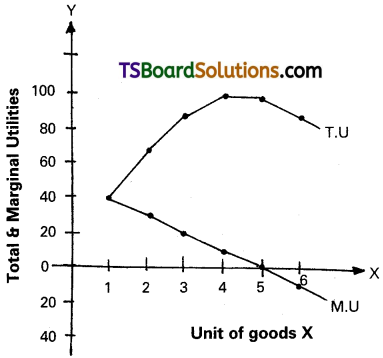
In the diagram, on ‘X’ axis measures units of apples and on Y axis measures total utility and marginal utility. TU curve represents total utility and MU curve represents marginal utility. TU curve is maximum at 5th unit where MU curve will become zero. TU curve slopes downwards from 6th unit, while MU become negative.
Limitations or Exceptions :
1) Hobbies :
This law does not operate in the case of hobbies like collection of stamps, old paintings, coins etc. Greater the collections of a person, greater is his satisfaction. Marginal utility will not diminish.
2) Drunkers :
It is pointed out that the consumption of liquor is not subject to the law of diminishing marginal utility. The more a person drinks liquor, the more he likes it.
3) Miser :
This law does not apply to money. The more money a person has the greater is the desire to acquire still more of it.
4) Further, this law does not hold good if there is any change in income tastes and preferences of the consumer.
Importance of the Law :
The importance of the law of diminishing marginal utility is as follows :
- The law of diminishing marginal utility is the basic law of consumption and it is the basis for the law of demand, the law of equimarginal utility etc.
- The changes in design, pattern and packing of goods will be brought by the producers by keeping this law in view.
- The law explains the theory of value that the price of a good falls, when supply increases. Because with the increase in the stock of a good, its marginal utility diminishes.
- Diamond-water paradox can be explained with the help of this law. Due to relative scarcity, diamonds possess high exchange value and less use value. Similarly, water is relatively abundant and so it posseses low exchange value but more use value.
- This law helps the government while formulating taxation policies. The principle of progressive taxation is based on the law of diminishing marginal utility. This law is more useful in the policies of redistribution of income and wealth in favour of the poor people.
![]()
Question 2.
Discuss the consumer’s equilibrium with the help of law of equimarginal utility.
Answer:
Law of equimarginal utility is an important law of consumption. It is called as “Gossen’s Second Law”, as its formulation is associated with the name of H.H. Gossen.
According to Marshall, “If a person has a thing which can be put to several uses, he will distribute it among these uses in such a way that it has the same marginal utility in all uses. If it had a greater marginal utility in one use than in another, he would gain by taking away some of it from the second and applying it to the first”.
According to this law the consumer has to distribute his money income on different uses in such a manner that the last rupee spent on each commodity gives him the same marginal utility. Equalisation of marginal utility in different uses will maximise his total satisfaction. Hence, this law is known as the “Law of equimarginal utility”.
The fundamental condition for consumer’s equilibrium can be explained in the following way.

Where, MUx, MUy, MUz, MUm = Marginal utilities of commodities x, y, z, money (m), and Px, Py, Pz = Prices of x, y, z goods.
This law can be explained with the help of a table. Suppose the consumer is prepared to spend his money income is ₹ 26/- on two goods say X and Y. Market prices of two goods are ₹4/- & ₹ 5/- respectively. Now the marginal utilities of good X, good Y are shown below.
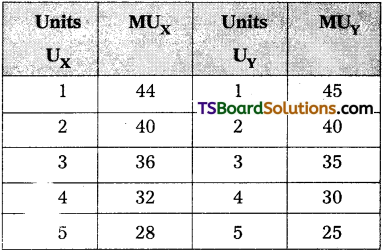
For explaining consumer’s maximum satisfaction and consequent equilibrium position we need to reconstruct the above table by dividing marginal utilities of X by its price ₹ 4/- and marginal utility of Y by ₹ 5/-. This is shown in the following table.
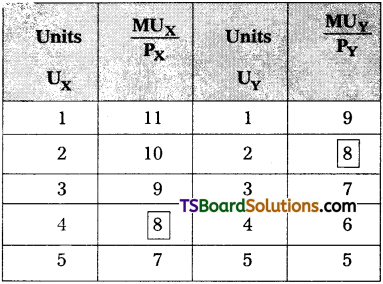
In the table it is clear that when consumer purchases 4 units of goods X & 2 units of good Y. Therefore, Consumer will be in equilibrium when he is spending (4 × 4 = 16 + 2 × 5 = 10) ₹ 26/- on them.
Assumptions of the law :
The law of equimarginal utility depends on the following assumptions.
- This law is based on cardinal measurement of utility.
- Consumer is a rational man always aiming at maximum satisfaction.
- The marginal utility of money remains constant.
- Consumer’s income is limited and he is proposed to spent the entire amount on different goods.
- The price of goods are unchanged.
- Utility derived from one commodity is independent of the utility of the other commodity.
Limitations of the law :
The law of equimarginal utility has been subject to certain limitations which are as given below :
- The law assumes that consumer is a rational man and always tries to get maximum satisfaction. But, in real life, several obstacles may obstruct rational behaviour.
- This law is not applicable when goods are indivisible.
- The law is based on unrealistic assumptions like cardinal measurement of utility and marginal utility of money remains constant. In real world, MU of money does not remain constant.
- This law will not be applicable to complementary goods.
- Another limitations of this law is that there is no fixed accounting period for the consumer in which he can buy and consume goods.
Importance of the Law :
The law of equimarginal utility is of great practical importance in economics.
1) Basis of Consumer Expenditure :
The expenditure pattern of every consumer is based on this law.
2) Basis for Savings and Consumption :
A prudent consumer will try to distribute his limited means between present and future consumption so as to have equal marginal utility in each. This is how the law guides us.
3) In the Field of Production :
To the businessman and the manufacturer the law is of special importance. He works towards the most economical combination of the factors of production. For this he will substitute one factor for another till their marginal productivities are the same.
4) Its application to Exchange :
In all our exchanges, this law works. Exchange is nothing but substitution of one thing for another.
5) Price Determination :
This principle has an important bearing on the determina¬tion of value and price.
6) Public Finance :
Public expenditure of a government conforms to this law. Taxes are also levied in such a manner that the marginal sacrifice of each tax payer is equal.
Question 3.
Illustrate the consumer’s equilibrium using indifference curve analysis. [Mar. 17, 16]
Answer:
A consumer is said to be in equilibrium with given his tastes, prices of the two goods and income on the purchase of two goods in such a way so as to get the maximum satisfaction :
I. Assumptions :
The analysis of consumers equilibrium is based on the following assumptions :
- Consumer has an indifference map showing his scale of preferences which remains the same throughout the analysis.
- Money income is given and constant.
- Prices of the two goods are given and constant.
- The consumer is rational and thus maximizes his satisfaction.
- There is no change in tastes, preferences and habits of the consumer.
- There is a perfect competition in the goods market.
II. Conditions of Equilibrium :
There are two conditions that must be satisfied for the consumer to be in equilibrium. These are : i) At the point of equilibrium, the budget / price line must be tangent to the indifference curve at its minimum point, ii) At the point of equilibrium, the consumer’s MRSxy and the price ratio must be equal, i.e. MRSXY = Px/Py.
This can be shown in the following diagram.
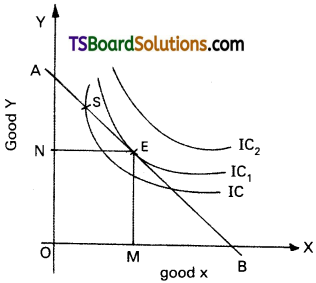
In the diagram ‘AB’ is consumer’s budget or price line. IC, IC1, IC2 are indifference curves. In the diagram the consumer is equilibrium at OM of x and ON of y. At point E the price line touches to ‘O’ IC1. At point ‘S’ consumer will be on lower indifference curve IC and will be an getting lesser satisfaction than at E on IC. IC2 is beyond the capacity of consumer. So it is outside to the budget line.
Short Answer Questions
Question 1.
Explain the concept of utility analysis. What are its shortcomings?
Answer:
The concept of utility was introduced in economic thought by Jevans in 1871. In a general sense, utility is the want satisfying power’ of a commodity or service. In economic sense, utility is a psychological phenomenon. It is a feeling of satisfaction, a consumer derives from the consumption of a commodity. Utility has nothing to do with usefulness. Utility and usefulness are different. A commodity may satisfy a human want but it may not be useful. For example, wine is harmful to health but satisfies the want of a drunkard. Whether the good is useful or not, if it satisfies a human want we can say that it possesses utility.
Utility is a subjective concept. It differs from person to person, from time to time and place to place. As regards to the measurement of utility, there are two different approaches :
1. Cardinal utility and
2. Ordinal utility. Let us introduce then in brief.
Shortcomings of Utility Analysis :
The following are the main defects pointed out on utility analysis.
- Cardinal measurement is not possible.
- Assumption of rational consumer is not correct.
- Wrong assumption of independent utilities. Utility of a good depends on other goods also.
- Assumption of constant marginal utility of money is wrong.
- One commodity model is unrealistic.
- Income effect, price effect and substitution effect are not clearly brought out.
- This analysis fails to explain the demand for indivisible goods.
![]()
Question 2.
Explain the concepts of Cardinal Utility, Ordinal Utility, Total Utility and Marginal Utility.
Answer:
The concept of utility was introduced in economic thought by Jevans in 1871. In a general sense, utility is the ‘want satisfying power’ of a commodity or service. In economic sense, utility is a psychological phenomenon.
1) Cardinal utility :
Utility is cardinal in the sense that utility is measurable in terms of units called utils. According to the concept of cardinal utility, the utility derived from the consumption of a good can be expressed in terms of numbers such as 1, 2, 3, 4 and so on. For example, a person can say that he derives utility equal to 10 utils from the consumption of one unit of commodity A and 5 utils from the consumption of one unit of commodity B. He can compare different commodities and express which commodity gives him more util¬ity or satisfaction and by how much. Alfred Marshall followed this approach. The law of diminishing marginal utility and the law of equi-marginal utility are based on cardinal utility approach.
2) Ordinal utility :
Utility is ordinal in the sense that utilities derived from the consumption of commodities cannot be measured quantitatively but can be compared by giving ranks. It means that the utilities obtained by the consumer from different commodities can be arranged in a serial order such as 1st, 2nd, 3rd, 4th etc. These numbers tell us that the second number is more than the first number. But, it is not possible to tell how much, because they are not measurable. J.R. Hicks and R.J.D. Allen have used the ordinal approach. The indifference curve analysis is based on ordinal utility approach.
3) Total Utility and Marginal Utility :
a) Total Utility : Total utility is the total amount of satisfaction which a person gets from the consumption of all units of the commodity. Let us assume that a consumer con-sumed 3 apples and first apple gave him 20 utils of utility, second one 15 utils and the third one 10 utils of utility. By adding these utilities we get the total utility, ie., 20 + 15 + 10 = 45. When the quantity of consumption increases total utility also increases but at a diminishing rate. The total utility is a function of total quantity.
TUn = f(Qn)
Where TUn = Total utility of n commodity,
f = functional relationship, and
Qn = Quantity of n commodity.
b) Marginal Utility :
Marginal utility is the addition made to the total utility by consuming one more unit of the commodity. Let us assume that one apple gives 20 utils of utility and 2 apples gives 35 utils of utility. It means that the additional utility from the second apple is 15 utils i.e., 35 – 20 = 15. This is called marginal utility. It can be expressed
MUn = TUn – TUn-1
where, MUn = Marginal utility of nth unit, TUn = Total utility of nth units, and
TUn-1 = Total utility of n – 1 units.
In the example, marginal utility of the second unit is equal to
MU2 = TU2 – TU1 = 35 – 20 = 15
Marginal utility can also be expressed in the following way :
![]()
By adding all the marginal utilities of different units of the commodity, we get total utility.
Question 3.
Define the law of diminishing Marginal Utility. State its assumptions.
Answer:
The law of diminishing marginal utility was originally explained by Hermann Heinrich Gossen in 1854. Jevans called it as Gossen’s first law. But Alfred Marshall popularised this law and analysed it in a scientific manner.
Definitions of the law :
“The additional benefit which a person derives from a given increase of his stock of a thing diminishes with every increase in stock that he already has” – Alfred Marshall.
Assumptions :
The law is based on the following assumptions :
1) Rationality :
The consumer is a rational human being in the sense that he seeks to maximize his satisfaction.
2) Cardinal Measurement of Utility :
Utility is a cardinal concept, i.e. utility is measurable quantitatively. It can be measured in cardinal numbers.
3) Independent Utility :
The utility of any commodity depends on its own quantity, i.e. utility of goods are independent.
4) Constant Marginal Utility of Money :
The marginal utility of money remains constant.
5) Homogeneous Goods :
Goods are homogeneous in the sense that they are alike both quantitatively and qualitatively.
6) Uniform Size of Goods :
Goods should be of suitable size, i.e. neither too big nor too small. They should be identical.
7) No Time Lag :
There is no time lag between the consumption of one unit to another unit.
8) Divisible Commodity :
Commodity is divisible.
9) No Change in Consumer Behaviour :
The income, tastes and preference of the consumer should remain constant.
10) Full Knowledge of the Market :
Consumer will have full knowledge of market.
![]()
Question 4.
Examine the limitations of the law of diminishing Marginal utility. Analyse its importance.
Answer:
The law of diminishing marginal utility was originally explained by Hermann Heinrich Gossen in 1854. Jevans called it as Gossen’s first law. But Alfred Marshall popularised this law and analysed it in a scientific manner.
Meaning :
The law says that as a consumer takes more units of good, the extra satisfaction that he derives from extra unit of a good goes on falling. The relationship between quantity consumed and utility derived from each successive unit consumed is called the law of diminishing marginal utility.
Limitations of the Law :
The following are some of the exceptions to the law of diminishing marginal utility:
1) Rational Consumer :
The consumer should be an economic human being with rational behaviour. If he is under the influence of an intoxicant, the utility of the later units will rise in the beginning but ultimately it falls and even becomes negative.
2) If goods are not independent, this law will not work. Complimentary goods can be one of the example.
3) Marginal utility of money is not constant. Our desire for money increases as we have more of it. The marginal utility of money will not be zero, but definitely it falls, when a person acquires more and more money.
4) If the goods are not homogeneous, this law will not work.
5) If the goods are too big or too small in size, problem arises. If the size is too big, consumer may not require second unit and similarly if the size is too small. Utility of the subsequent units may increase.
6) In the case of durable goods, it is not possible to calculate their utility because their use is spread over a period of time. A consumer does not buy more durable goods for personal consumption.
7) If there is any change in consumer’s income or tastes or habits, this law does not hold good.
8) If the goods are not ordinary, like diamonds or hobby goods like stamps and coins, the utility of the additional units may be greater than the earlier units. Infact law is applicable in these cases also. The collector of stamps or coins never like to have innumerable pieces. The person may not collect more than one or two of the same coin or same stamp.
Importance of the Law :
- The law of diminishing marginal utility is the basic law of consumption and it is the basis for the law of demand, the law of equi-marginal utility etc.
- The changes in design, pattern and packing of goods will be brought by the producers by keeping this law in view.
- The law explains the theory of value that the price of a good falls when supply increases. Because with the increase in the stock of a good, its marginal utility diminishes.
- Diamond water paradox can be explained with the help of this law. Due to relative scarcity, diamonds possess high exchange value and less use value. Similarly, water is relatively abundant and so it posseses low exchange value but more use value.
Question 5.
Explain the concept of law ofequi-marginal utility. Point out its assumptions.
Answer:
This is an important law of consumption and was derived from the law of diminishing marginal utility. It is known by various names such as the law of equi-marginal utility, the law of substitution, the law of maximum satisfaction etc. It is also called as Gossen’s Second Law as its formulation is associated with the name of H.H. Gossen. The law of diminishing marginal utility explains the consumer’s behaviour, consuming only one good. But in actual life, consumer buys a certain combination of goods with his limited income and maximises utility. The law of equimarginal utility explains the same.
Definition of the Law :
“If a person has a thing which can be put to several uses, he will distribute it among these uses in such a way that it has the same marginal utility in all. If it has a greater marginal utility in one use than in another, he would gain by taking away some of it from the second and applying it to the first.” – Alfred Marshall.
Assumptions of the Law :
The law of equimarginal utility depends on the following assumptions :
- Cardinal measurement of utility is assumed.
- Rationality on the part of the consumer so as to get maximum satisfaction and to attain equilibrium is also assumed.
- Marginal utility of money remains constant.
- The income of the consumer is given and remains constant and he spends entire amount on different goods.
- The prices of goods are given and constant.
- Utilities are independent.
![]()
Question 6.
Discuss the limitations and importance of law of equimarginal utility.
Answer:
Definition of the Law :
“If a person has a thing which can be put to several uses, he will distribute it among these uses in such a way that it has the same marginal utility in all. If it has a greater marginal utility in one use than in another, he would gain by taking away some of it from the second and applying it to the first.” -Alfred Marshall.
Limitations of the Law of EquiMarginal Utility :
The equimarginal principle is subject to certain limitations which may be set forth hereunder :
- The law is based upon the assumption of rationality on part of the consumer. But in real life, several obstacles may obstruct rational behaviour.
- This law works out fully only if the goods are divisible. If goods happen to be large and indivisible, it is not possible to equate the marginal utility of money spent on them.
- Non availability of certain goods prevents the consumers from maximizing their satisfaction out of their expenditure. Therefore, the law fails to work.
- Prices of goods often fluctuate in the market with the result that their utilities also keep changing from time to time. This prevents the working of the law.
- The law of maximum satisfaction will not be applicable to complementary goods.
- Another limitation of this law is that there is no fixed accounting period for the consumer in which he can buy and consume goods.
- Cardinal measurement of utility, marginal utility of money remaining constant etc., are not realistic assumptions. They are not valid.
- It is assumed that the consumer has a perfect knowledge. But this is not correct.
Importance of the Law :
The law of equimarginal utility is of great practical importance in economics.
1) Basis of Consumer Expenditure :
The expenditure pattern of every consumer is based on this law.
2) Basis for Savings and Consumption :
A prudent consumer will try to distribute his limited means between present and future consumption so as to have equal marginal utility in each. This is how the law guides us.
3) In the Field of Production :
To the businessman and the manufacturer the law is of special importance. He works towards the most economical combination of the factors of production. For this he will substitute one factor for another till their marginal productivities are the same.
4) Its application to Exchange :
In all our exchanges, this law works. Exchange is nothing but substitution of one thing for another.
5) Price Determination :
This principle has an important bearing on the determina¬tion of value and price.
6) Public Finance :
Public expenditure of a government conforms to this law. Taxes are also levied in such a manner that the marginal sacrifice of each tax payer is equal.
Question 7.
What is an indifference curve? What are its assumptions?
Answer:
Indifference curve :
An indifference curve represents satisfaction of a consumer from two commodities. An IC curve can be defined as the locus of points each representing a different combination of two goods yielding the same level of satisfaction.
Assumptions :
1) Rationality :
It is assumed that the consumer tries to obtain maximum satisfaction from his expenditure.
2) Scale of preference :
Consumer is able to arrange the available combinations of goods according to scale of preference.
3) Ordinal utility :
It assumes ordinal utility approach. So utility is in measurable only ordinal terms i.e., 1st, 2nd, 3rd etc.
4) Diminishing marginal rate of substitution :
It is the rate at which a consumer is willing to substitute commodity to another. So that this satisfaction remains the same.
5) Consistency :
Consumer’s choices have to be consistent. It means if consumer prefers A to B and B to C his choice reflects his rationality.
6) Completeness :
The consumer’s scale of preferences is to complete that he is able to choose any one of the two combinations of commodities presented to him.
Question 8.
Explain the concept of indifference curve. Discuss its properties.
Answer:
An indifference curve can be defined as the locus of points each representing a different combination of two goods yielding the same utility or level of satisfaction. Therefore, a consumer is indifferent between any two combinations of goods when it comes to making a choice between them. It is also called iso – utility curve or equal utility curve.
Indifference Schedule :
An indifference curve is drawn on the basis of an ‘indifference schedule’. It may be defined as a schedule of various combinations of two goods which yields same level of satisfaction.
| Combinations | Commodity X | Commodity Y |
| 1 | 1 + | 15 |
| 2 | 2 + | 11 |
| 3 | 3 + | 8 |
| 4 | 4 + | 6 |
| 5 | 5 + | 5 |
The table shows five combination of two goods, X and Y, which give the same utility. The consumer’s satisfaction from 1st combination (1 unit of X + 15 units of Y) is the same as that of other combina- o tion i.e., 2nd, 3rd, 4th and 5th. Since all combinations yield the same level of satisfac- g tion, the consumer is indifferent among these combinations.
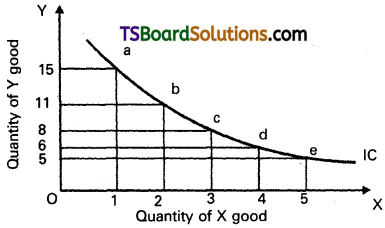
Indifference Curve :
Basing on the indifference schedule, we can draw an indifference curve.
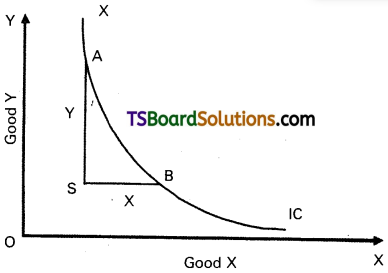
In the above figure, good X is measured on the OX-axis. Good Y is measured on OY – axis. Consumer’s utility at point a on the IC with 1 unit of good X and 15 units of good Y, is equal to the utility at point b with 2 units of X and 11 units of Y or at point C with 3X and 8Y and so on. These combinations give him the same level of satisfaction. If we join the points a, b, c, d and e, we get an indifference curve (TC) and utility as all points on this curve are same. Hence, the consumer is indifferent regarding the combinations.
When the consumer moves from A to B on IC, he gives up AS of Y (∆Y) for SB of X (∆X).
Properties of Indifference Curves :
Indifference curves have the following basic properties :
1) An indifference curve is negatively sloped towards down. It implies that when the amount of one good in combination is increased, the amount of other good is reduced. This is essential if the level of satisfaction is to remain the same on an indifference curve. It is neither positively sloped towards up nor horizontal.
2) Indifference curves are always convex to the origin. The convexity rule implies diminishing marginal rate of substitution. Indifference curves cannot be concave to the origin.
3) Indifference curves can never intersect each other. If two IC curves intersect, it would imply that an indifference curve indicates two different levels of satisfaction. It is not proper.
4) A higher indifference curve represents a higher level of satisfaction than a lower indifference curve. In other words, an IC to the right represents more satisfaction. This is because of combinations lying on a higher IC contain more of either one or both goods. Similarly, an indifference curve to the left represents less satisfaction.
![]()
Question 9.
How do you define Budget line of the consumer.
Answer:
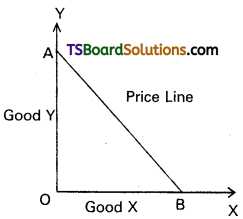
The budget line or price line shows all possible combinations of two goods that a consumer can buy with the given income and prices of the two goods.
The concept of budget / price line will be shown in the following example. Suppose that a consumer has ₹ 150 (income) to buy two goods namely X and Y. Whose prices are ₹ 15 and ₹ 30 each. With the given information now we can draw the budget or price line as shown in the diagram.In the diagram AB’ is the ‘budget or price line’.
The slope of the line AB represents the ratio of the prices of X and Y in such a manner that 10 of X will be equal to 5 of Y.
Very Short Answer Questions
Question 1.
Define Utility.
Answer:
The want satisfying power or capacity of a commodity or service is known as utility. It is the basis of consumer’s demand for a commodity.
Question 2.
Explain Cardinal utility. [Mar. 17]
Answer:
Alfred Marshall developed cardinal utility analysis. According to this analysis, the utilities derived from consumption of different commodities can be measured in terms of arbitary units called utils. 1, 2, 3, 4 are called cardinal numbers.
Question 3.
Explain Ordinal utility.
Answer:
This was developed by J.R. Hicks, Allen. Utility is subjective and measurement of utility in numerical terms is not possible. We can observe the preference for one good more than for another. Ordinal numbers such as 1st, 2nd, 3rd etc. The ordinal numbers are ranked.
Question 4.
Explain Total utility.
Answer:
Total utility is the total amount of utility which a consumer derives from a given stock of a commodity.
TUn = f(Qn)
Question 5.
Define Marginal utility.
Answer:
Marginal utility is the additional utility obtained from the consumption of additional unit of the commodity.
MUn = TUn – TU(n-1)
(or)
MU = \(\frac{\Delta \mathrm{TU}}{\Delta \mathrm{Q}}\)
![]()
Question 6.
What is Price Line / budget line?
Answer:
It shows all possible combinations of two goods that a consumer can buy, with the given income and prices of the two goods.
Question 7.
Explain law of diminishing marginal utility.
Answer:
The law of diminishing marginal utility is based on the fact that though human wants are unlimited, but any particular want is satisfiable. This law analyses consumers’ behaviour in case of a single good. If a person goes on consuming more and more units of a commodity, the additional utility he derives from the additional units of the commodity goes on diminishing. This phenomenon of human behaviour is explained by this law. The law of diminishing marginal utility explains the relationship between the quantity of goods consumed and the utility derived.
Question 8.
Explain law of equi-marginal utility.
Answer:
The law states that a consumer having a fixed income and facing given market prices of goods will achieve maximum satisfaction when the marginal utility of the last rupee spent on each good is exactly the same as the marginal utility of the last rupee spent on any other good. Equalisation of marginal utilities will maximize the consumer’s satisfaction and consumer attains equilibrium. The fundamental condition for consumer’s maximum satisfaction and equilibrium of the consumer.
Question 9.
What is scale of preference?
Answer:
Guides the consumer in his purchases.
Question 10.
Explain Marginal rate of substitution.
Answer:
The additional amount of one product required to compensate a consumer for a small decrease in the quantity of another, per unit of the decrease.
This can be explained with the help of table.
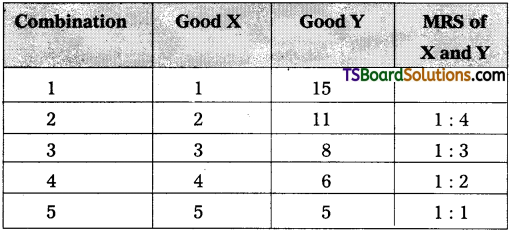
By the table, the consumer is ready to sacrifice 4 units of Y to get 1 more unit of X. The MRSX for diminishes.
Question 11.
Draw the indifference map.
Answer:
A set of indifference curves drawn for different income levels is called indifference map.
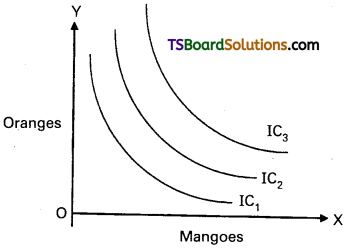
From the above diagram it is clear that an indifference map of IC1, IC2, IC3. Each curve shows a certain level of satisfaction to the consumer.
Question 12.
Explain the relationship between total utility and marginal utility.
Answer:
The relationship between total utility and marginal utility is explained in three ways.
They are :
- When total utility increases at a diminishing rate, marginal utility falls.
- When total utility is maximum, marginal utility becomes zero.
- When total utility decreases, marginal utility becomes negative.
![]()
Question 13.
Write in brief, about the properties of indifference curves.
Answer:
It represents the satisfaction of a consumer from two goods of various combinations. It is drawn and the assumption that for all possible combinations of the two goods on an indifference curve, the satisfaction level remains the same.